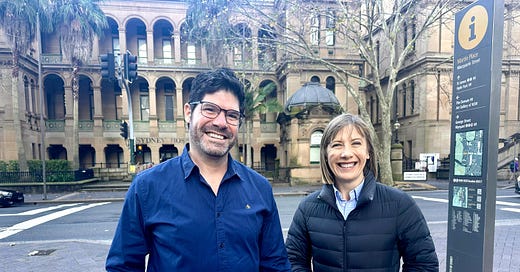Presidents Message
Recently I had a ‘walking meeting’ with Minister Haylen where we discussed a number of issues ranging from 30km/h, the need for more active travel funding and TfNSW culture. There was also a chance for some myth-busting like the illusory benefit of travel time savings for private cars, the case for Elizabeth Drive being evidence-based, and the ‘coffers being empty’ in light of the $0.8bn (that’s 3/4 of an Opera House) being spent on the same. As I said to the Minister, it is a double standard that we see this as ‘redundancy’ in public transport (eg: buses and light rail) as bad, ditto cycling and walking paths, but call the same approach to motorised travel ‘resilience’. I am pleased to hear the office is looking to trial 30km/h in the Inner West (although by now we should be past trials), and do much more for Victoria and Parramatta Roads. We look foward to more productive meetings in the future.
I was disheartened that the Premier has since weighted in both the City of Sydney’s speed proposal and the light rail proposal for Parramatta Road. Along with the Road Minister and his $0.8bn Drive, I worry that men above Minister Haylen with ‘car-brain’ are continuing to block progress.
This was reinforced in the time I’ve spent overseas. In London, an international 20mph city, I met up with a few old colleagues and new friends, and everyone in the industry from London Living Streets to Clean Cities and the Great British Rail Transition Team is very excited about the new Starmer government which in only 2 weeks has already moved quickly to secure new ground. Some lessons:
Labour laid out their plans in advance for fast action - a good example of this is the manifesto Getting Britain Moving. The contain a “mission-driven government” - 5 missions that add up to Labour’s vision for the future. Each mission is SMART - and all policies are intended to contribute to them (tho some are quite specific eg: “Get the NHS back on its feet”).
Each manifesto is split into Labour’s Plan for Urgent Action - the immediate actions, and Labour’s Plan for Change - the longer term actions.
A user-focused approach - Sadiq also had this in MTS3 eg: “A Good Public Transport Experience” - and so does the plan - ‘More Reliable Services’, ‘Accessible Services’, ‘Safe Services’.
A King’s Speech that has set out the legislative path for each of the ‘Plans for Urgent Action’ - so Labour is quickly moving to change before they get stuck in the inertia of knee-jerk politics and bureaucracy.
Transport Ministers that know their business - Peter Hendy, the new Minister of State (Rail) is the former head of Transport for London, Louise Haigh (Secretary of State for Transport), a firebrand that has led the rail re-nationalisation push, and Lilian Greenwood, Minister for The Future of Roads (and an avid walker).
Wales, where 20mph was rolled out across the country, was not rolled back via the ballot box as some expected - in fact no Tory candidates who lobbied against it got in. While they are making minor tweaks for major roads, it has now been validated by popular vote. Some Australian newspapers misreported the election as vindicating resistance against slow speed - in the UK this was laughed at.
The city is also so quiet these days with barely any traffic on most roads, and electric vehicles (taxis, buses) where there are vehicles. Walking and cycling is booming.
I then went to another 30km/h city, Paris. The centre of Paris is fascinating - having shut even the Metro in parts, the streets are literally heaving with walkers and bikers:
When traffic did return to some routes after the opening ceremony, it was barely perceptible. Volumes are so low that you can now cross all streets from the Grands Boulevards to the Seine without waiting for signals. In some areas, signals are being removed! In fact, Paris too was so quiet they have a new problem - squashed birds, who have not yet adjusted to the silent progress of the occasional bike or EV.
Outside the major cities, from Bath to Brie, they are pulling forward and leaving Australia behind. The amount we are spending on expanding our city and its roadways is staggering by comparison, literally billions being wasted that could be better spent on schools, health, social housing or equitable transport. This may be related to another issue (according to the speakers at a festival in Oxfordshire) - feeding greed and the news cycle, instead of building community - but I digress.
Last, on a personal level, I feel so much fitter than that unflattering photo above. Four weeks walking 12km a day again has made me realise how sedentary I have become in Sydney. Another reminder the insidiousness of the ‘personal choice’ type arguments [of late-stage capitalism] to abrogate responsibility for social issues like transport and health. I hope to bring back more lessons, and perhaps find a more receptive audience after Lee Waters has spoken to the Ministers about the realm of the possible.
Annual General Meeting
If anyone is interested in standing for the board please let us know ASAP - you will need to be nominated and seconded, and we would love to meet for a chat first. Please contact us.
Join us in the WalkSydney AGM on Monday, 19 Aug • 12:00 – 1:00 pm (AEST)
Video call link: https://meet.google.com/ows-gach-pvu
Or dial: +44 20 3873 3170 PIN: 463 859 342 9810#
Come Join Us
WalkSydney is dedicated to making it easier and safer and more accessible to walk, but we can’t do this alone. We need your help to grow our small organisation. About 4x as many people read this newsletter than are members, so if you aren’t a member, consider signing up. We would love your help to recruit like-minded friends, so that we can strengthen our advocacy impact!
We are asking you to ask a friend or college to join our organisation and be a part of an impactful movement!
We meet regularly with the office of the Minister for Transport and for Roads, advocating for 30km/h, better and more frequent crossings and greater investment in infrastructure to support walking. This year we have also written over 20 submissions, to various inquiries advocating to make it easier to walk. But we need your help to continue this important work, and to spread the message to your local area. Your voice matters—help by joining, encouraging others to join, and make a difference!
Vision Zero or Zero Vision?
Damien Cahill’s book “Wrong Way” provides a scathing analysis of many Australian political choices from stripping out the public service to privatising child care by asking the simple question “did the policy achieve its original objective”?
In a similar vein, we can leave aside our views and ask of NSW Road Safety, is it achieving its aims? In 2012 it adopted the Road Safety Strategy 2012 - 2021, which sought to contribute to the National Road Safety Strategy target (2011) of 30% reduction in road death by 2020. The number of fatalities and serious injuries on NSW roads in 2011 was 364 and 6855 respectively. 73% of pedestrian casualties were in Major Cities, being 13% of overall casualties.
The NSW Government then published a Future Transport Strategy 2056 (in 2018), which included a new Road Safety Plan 2021 reiterating that target (enumerated as 287 or less killed in 2021), a future 2026 “ten year target” TBA, and committing to a new target of zero by 2056, aka “Vision Zero”. The plan is road infrastructure and education heavy. The plan does not include the measures adopted in Scandinavian countries going ‘Beyond Vision Zero’ since 2017, such as better walk and cycle infrastructure for vulnerable road users, or lower speeds to reduce serious injuries.
By 2020, only 297 had been killed, a 19% reduction, seen as ‘on target’ to 30% by 2021. In 2021 it achieved the stated target of 30% reduction / 287 or less, with 270 fatalities. Of course, this was in the middle of COVID-19, however, and since traffic has returned to ‘normal’, we have seen a jump back up to a YTD total of 358 deaths (that’s only 2% less than in 2011 when the 30% target was set, and 133% of the toll when the first strategy ended). In other words, we have not achieved any further reductions under Vision Zero. Serious injuries, at 10,555, are 154% of when the initial target was announced. 14% are pedestrians (a 1% rise since 2011). The main thing that has fallen is metropolitan fatalities, from 73% in 2011, to 39% in 2024 (YTD). In other words we have been prioritising regional roads (and road infrastructure, like dividers) at the expense of targeting overall deaths and serious injuries, and reducing the deaths of vulnerable road users, particularly pedestrians.
So, is it time to call Vision Zero (in its current form) dead and buried? Or put differently, how many more walkers deaths will it take for TfNSW to change track?
Oxford Street East
Good in parts, this project delivers little for walking and makes some questionable moves, particularly widening traffic lanes despite lowering speed. It is also beleaguered by local pressure groups like the Paddington Society. In our view, the scheme could also deliver more for walking, particularly the space currently given over to wider lanes, particularly as the pedestrian level of service is quite low (LOS E in parts, as calculated by Andrew Moss from BIKEast). We are conscious this may add time and cost - although there are solutions to minimise this - nevertheless are pushing for better.
A public domain workshop was held on 20 July and David Haertsch attended. There were also attendees from Better Streets, BIKEast and BikeNSW. Most of the comments were in favour of making the street more walkable, indeed, many residents who were there walk along the street to the city as it is, and supported making it more pleasant and walkable. There were 4 places identified for attention along the length of the street - The courthouse area; the Glenmore Road Junction; Paddington Town Hall and the reserve on the South side of the street outside Victoria Barracks; and the Top end intersection at the major gateway to Centennial Park. Making squares, particularly by closing or reducing some road mouths, were popular among community attendees.
However, there was no (room for) discussion about the carriageway and the possibility of more space for walking and public space by giving space to walkers and not cars - in keeping with the Road User Space Allocation policy and the low levels of service for walking along the street. There are pinch points that could be readily addressed with an ‘active transport first’ / ‘outside-in’ approach. We are discussing this separately with TfNSW’s urban designer on the project and made a suggestion outlining the above on the consultation that recently closed.
Federal Government Policy
WalkSydney provided input into the Federal Net Zero Consultation Roadmap, and the National Urban Policy, both of which are key to future federal support (and hopefully funding) of better walking conditions as part of a family of sustainable planning and transport outcomes. We were also among 56 groups representing 2.3 million people who provided a joint statement on the former, stating:
The government’s plan to decarbonise the transport sector must set strong targets to cut pollution in a fair, fast and inclusive way, shift to public, shared and active transport and accelerate electrification.
In the case of the National Urban Policy, we noted the Net Zero Roadmap had passed responsibility for walking and cycling action to the NUP (at pp 23 - 24) and suggested the opportunity to be succinct and metric-driven, by dividing the 7 objectives into components aligned to SDG 11.1 - 11.7 and 11.B, 3.6, 6.4, 6.6, 8.4, 9.1, 9.C, 12.2, 12.5 (16 principles). We also suggested the governemnt tie Federal funding to policies and projects that can demonstrate alignment to the policy, funding active transport and applying rigorous carbon tests on new road building. We also suggested:
‘Child-friendly cities’ are included, or at least some metrics on AT to schools
A need to focus road safety funding on speed reduction
A need to counter bias towards / planning for high car mode share
Other Items
Waverley Council have asked if local residents, workers or visitors to Waverley can fill in the following online survey to help develop their first strategic document on walking: https://haveyoursay.waverley.nsw.gov.au/
If you live in or around Dulwich Hill you may want to join this petition: https://actionnetwork.org/letters/better-streets-for-dulwich-hill
There is a webinar on bike paths and walking trails as biodiversity corridors in September: https://www.engineersaustralia.org.au/event/2022/05/bike-paths-and-walking-trails-biodiversity-corridors-57c4fdb1
Here’s some visual imagery in support of the latter from London:








Thanks for the info-rich newsletter👍